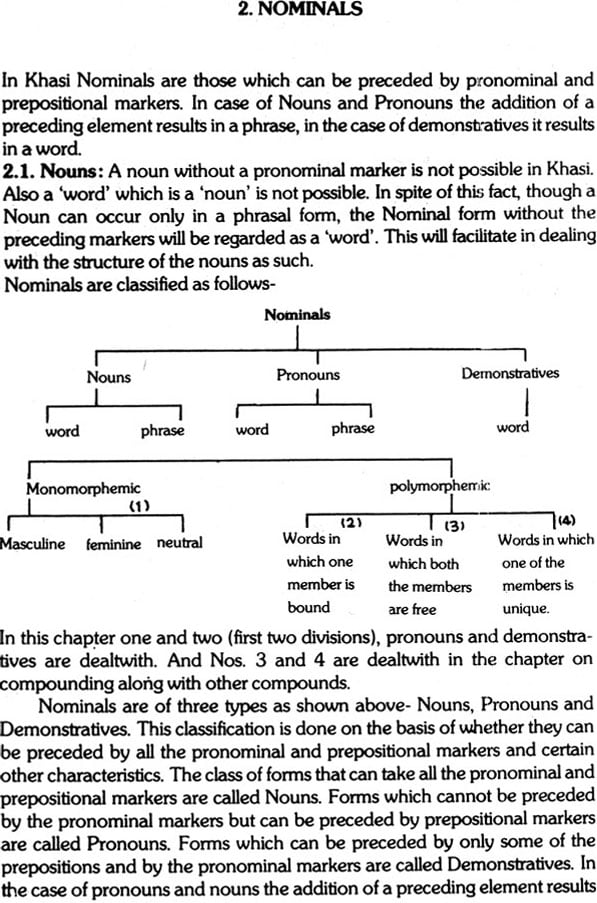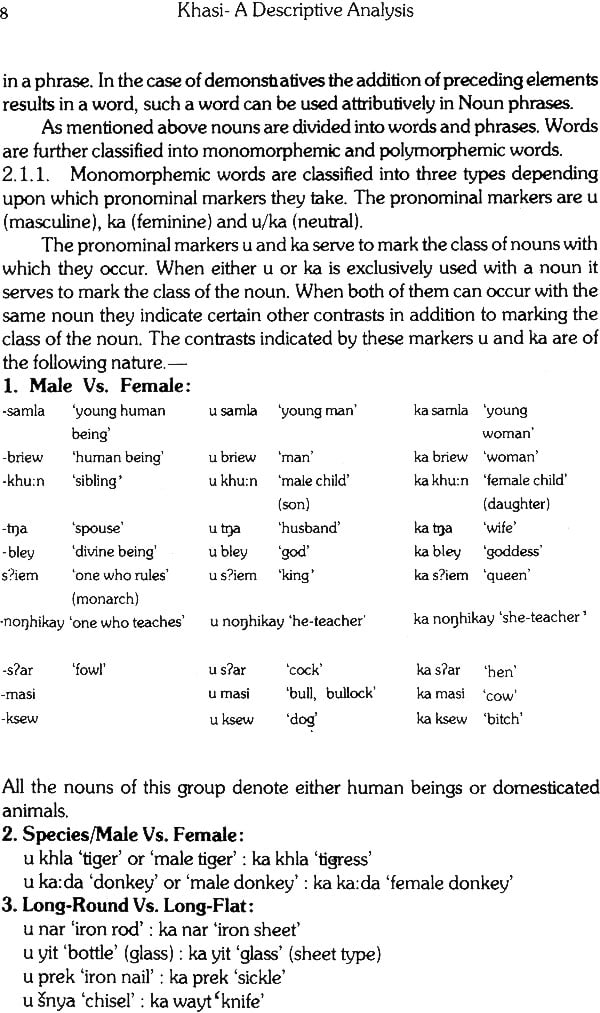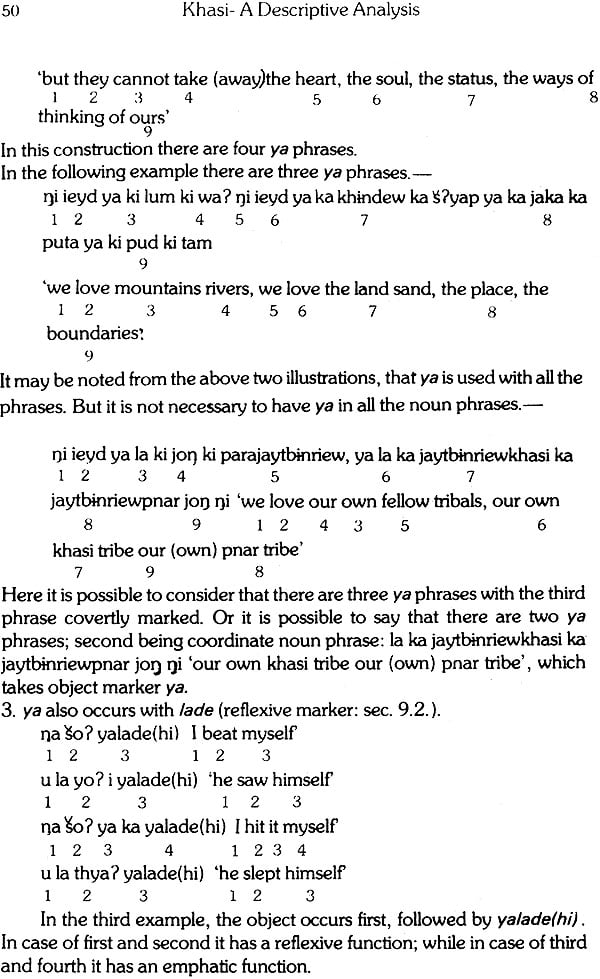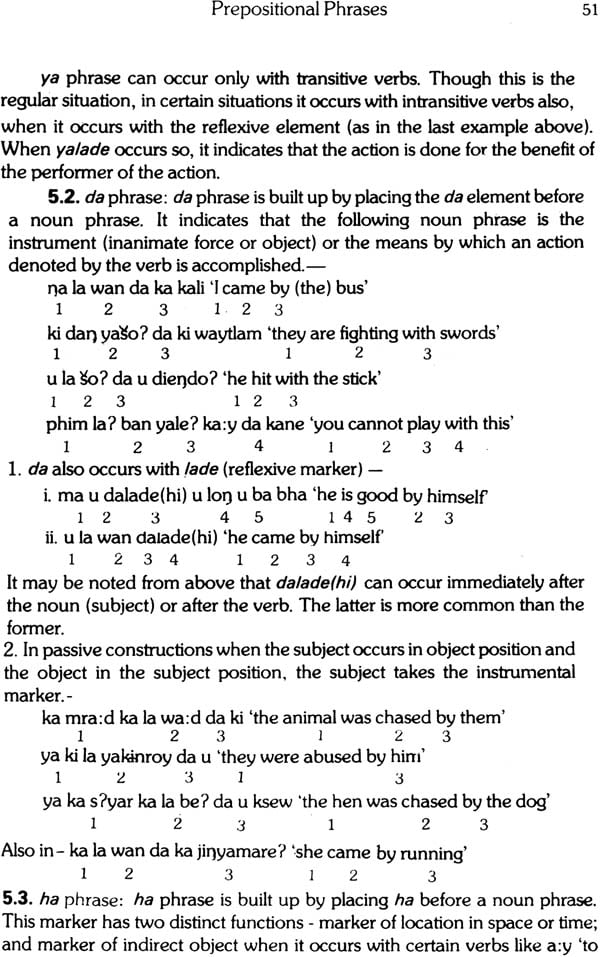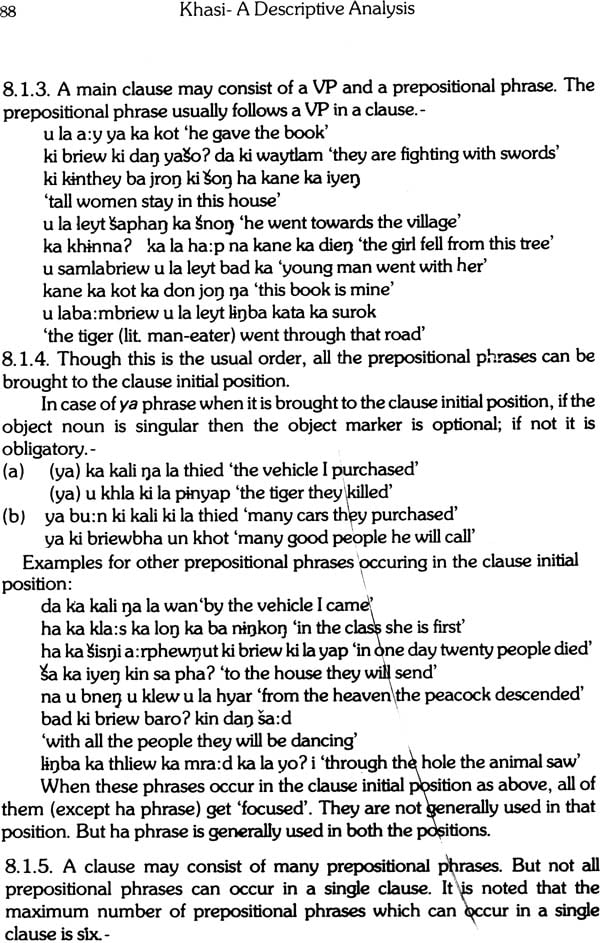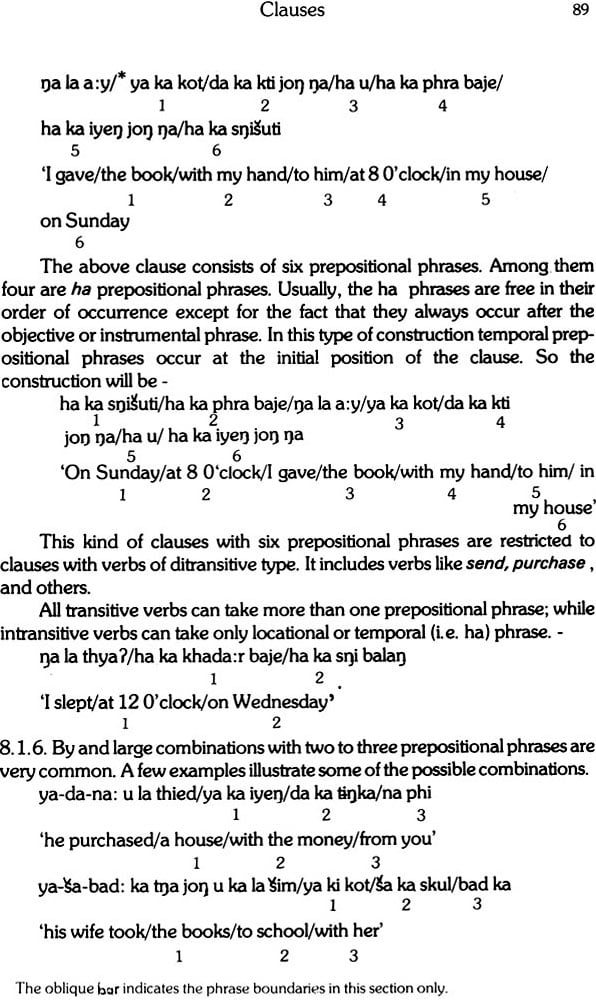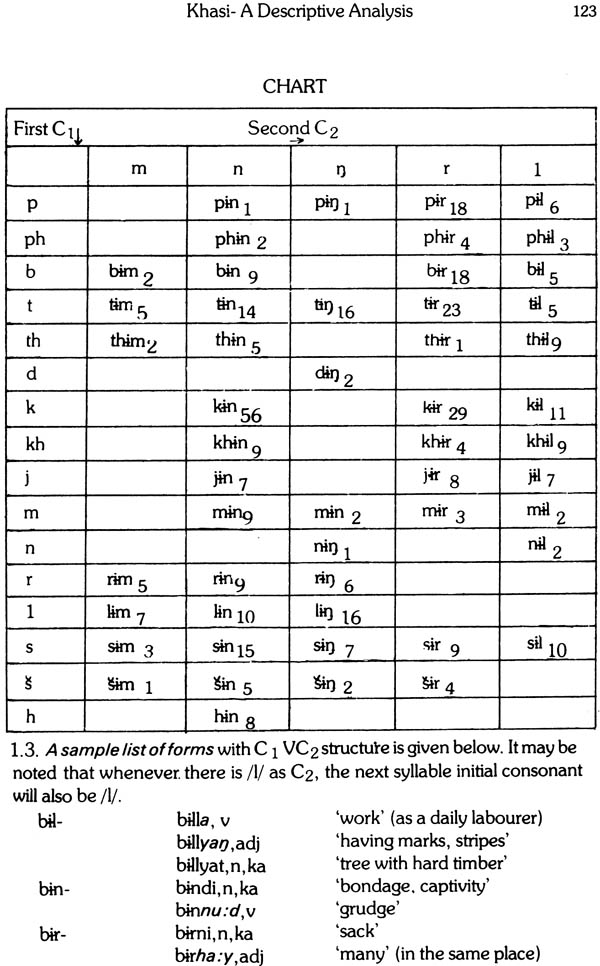
Khasi: A Descriptive Analysis (An Old and Rare Book)
Book Specification
| Item Code: | NAM128 |
| Author: | K. S. Nagaraja |
| Publisher: | Deccan College Postgraduate and Research Institute |
| Language: | English |
| Edition: | 1985 |
| Pages: | 148 |
| Cover: | Paperback |
| Other Details | 8.5 inch x 5.5 inch |
| Weight | 230 gm |
Book Description
1.1 Background: The term ‘khasi’ stands for both the tribe and the language. This language belongs to the Austroasiatic family of language.
1.1.1 Among the four major language families which are spoken in India, the Austroasiatic language family kakes the third position from the point of view of the number of speakers.
The language of Austroasiatic family are spoken in India and in South Asian countries. Austroasiatic language family consists of four branches: 1. Munda, 2. Mon-khmer, 3. Malacca and 4. Nicobarese (Thomas and Headley 1970). Later, Diffloth (1980) in his classification of Austroasiatic languages omits Malacca branch while retaining rest.
Khasi is the only language in India which belongs to the second branch. 1. The language of the first and the fourth branches too are spoken in India. It is interesting to note that all the languages belonging to this family which are spoken in India are spoken by people who inhabit only the hilly tracks and mountainous regions.
1.1.2 The Khasi people are one of the several tribes who inhabit the south-central section of the khasi and Jaintia hills of Meghalaya. The area covers 6157 sq. Miles, with the Khasi population of about 3,84,6062 speakers (including speakers of various dialects of Khasi has four major dialects (Grierson 1902).
1. Khasi proper which is considered as the standard and employed for all literary purposes, is spoken in and around Cherrapunji by 2,89,650 speakers;
2. Synteng (or Pnar or Jaintia) spoken in the Central Plateau of the Jaintia hills (i.e. Jowai sub-division) by 55,113 speakers;
3. Lyngngam, spoken in the south-west by about 14,673 speakers; and
4. War, spoken in the low southern valleys bordering the Sylhet plains of Bangla Desh by 3,854 speakers.
There is one more dialect called Bhoi Khasi (Acharya 1971) spoken in the northern lowlands of the district. Recently Hamlet Bareh (1977) provides an altogether different view on the issue of dialects of Khasi. According to him there are many more dialects than just four as listed in Grierson (1902). Bareh lists the following as dialects of khasi.
1. Amwi: spoken in the Southern Jaintia hills;
2. Shella: sourthern Khasi hills;
3. Warding another dialect of the south of Khasi hills;
4. Myriaw, Nongkhlaw, Nangspung, Maram, Mawiang; spoken in the mid-southern khasi hills;
5. Cherra: mid-southern khasi hills;
6. Nongkren, Mylliem, Laitlyngkot, Lyniong-khasi: spoken in the Central parts;
7. Jowai: Central Jaintia;
8. Bhoi: north-east khasi hills;
9. Manav, Nongwah, Jirang; north khasi hills;
10. Khadar Blong (Mawpran): mid-south: and
11. Nongstoin and Langrin: western khasi.
Further he is very sceptical about the status of Lyngngam dialect of Grierson’s classification, though he puts it under western dialects.
1.1.3. The Khasis form an island by themselves surrounded by speakers of different language families. They are supposed to have migrated from the southeast. They are primarily mongoloid in their structure and appearance. Khasi society is matriarchial and matrilocal.
1.1.4. Till the later part of the eighteenth century Khasis were illiterates. They did have any writing system. As Khasis had no indigenous script they adopted Roman script. The credit goes to the Welsh and Baptist missionaries who were mainly responsible in introducing the writing system; and writing books on and in Khasi. The first book in Khasi was printed in 1843. For the first half a century, books mainly on Christianity that too mostly translations were printed. But afterwards there has been more progress achieved in this field and many independent works have been written and published in this language.
At present Khasi is the medium of instruction in the primary schools. For all the literary and other writing purposes the dialect spoken around Cherrapunji is used.
1.1.5. Though there have been some earlier descriptions of Khasi (mainly by Roberts and Rabel), they were all partial treatments. It is hoped that the present analysis is the first detailed description of the language.
In this revised version, two major changes are made. One, as phonetics and phonology of the language have been dealt with in a separate monograph (Nagaraja: forthcoming), phonology is discussed very briefly in the present analysis. For this reason, a discussion on phonology has been incorporated in this section itself. Second, the separate treatment of Reduplication is withdrawn from this work as it has been converted into an article, and has appeared in Indo-Iranian Journal (1984). In this work suprasegmental features like stress, intonation are not analysed.
The analysis and the description follows the structural model with slight modifications in certain places. The analysis is based on the standard dialect spoken around Cherrapunji.
This analysis is the result of the work with informants for around five hundred hours during 1972-77. Two field trips one in 1973 and another in 1974 were undertaken to collect data on khasi. During these field trips data were collected from Shri. Hajar Singh, Shri. Bungster Roy, Shri. Tibor Singh Raji. Later data were checked and re-checked from Shri. Lionel Lingdoh, a student at Spicer’s Memorial College, Poona and Shri. Domnic Jala, student at papal Semenary, Poona. The last one was my main informant.
In Khasi very little of morphology is found. So, the analysis is put in two parts-1. Phonology and 2. Grammar. Under the latter whatever little morphology is there, is described.
| 1 | Introduction | 1 |
| 1.1 | Background | 1 |
| 1.2 | Notes on Phonology | 3 |
| 1.3 | Juncture | 5 |
| Grammar | ||
| 2 | Nominals | 7 |
| 2.1. | Nouns | 7 |
| 2.2 | Personal Pronouns | 10 |
| 2.3. | Demonstrative and Interrogative Pronouns | 11 |
| 2.4. | Nominal Phrases | 13 |
| 3 | Verbals | 26 |
| 3.1. | Structure of Verbs | 26 |
| 3.2. | Adjectives | 28 |
| 3.3. | Verb Phrase | 29 |
| 3.3.4. | Auxilliary verbs | 34 |
| 3.3.5. | Completive marker | 35 |
| 3.3.6. | Negative marker | 35 |
| 3.3.7. | Co-occurrence restrictions | 36 |
| 3.3.8. | Infinitival phrase | 37 |
| 4 | Adverbials | 39 |
| 4.1. | Manner adverbials | 39 |
| 4.2. | Frequency adverbials | 42 |
| 4.3. | Temporal adverbials | 43 |
| 4.4. | Prepositional adverbials | 44 |
| 4.5. | Pronominal adverbials | 46 |
| 5 | Prepositional phrases | 49 |
| 5.1 | ya phrase | 51 |
| 5.2. | da phrase | 51 |
| 5.3. | ha phrase | 51 |
| 5.4. | na phrase | 53 |
| 5.5. | sa phrase | 53 |
| 5.6. | bad phrase | 55 |
| 5.7. | jon phrase | 55 |
| 5.8. | ba phrase | 57 |
| 6 | Compounding | 58 |
| 6.1 | Noun compounds | 58 |
| 6.2. | Verb compounds | 63 |
| 6.3. | Idiomatic Compounds with two members | 65 |
| 6.4. | Three member compounds | 66 |
| 6.5. | Idiomatic Compounds with three members | 70 |
| 6.6. | Compounds with unique or near unique members | 70 |
| 6.7. | Contraction | 72 |
| 7 | Numerals | 79 |
| 7.1. | Basic Cardinal numerals | 79 |
| 7.2. | Numeral word vs. Phrase | 81 |
| 7.3. | Co-ordinate relations in Numerals | 82 |
| 7.4. | Ordinal numerals | 82 |
| 7.5. | Multiplicative numerals | 82 |
| 7.6. | Fractions | 83 |
| 7.7. | Units of measurement | 86 |
| 8 | Clauses | 87 |
| 8.1. | Main clause | 87 |
| 8.2. | Subordinate clause | 93 |
| 9 | Particles | 99 |
| 9.1. | Conjunctions | 99 |
| 9.2. | Reflexive marker | 101 |
| 9.3. | Emphatic marker | 102 |
| 9.4. | Indefinite/Reciprocal/Definite forms | 103 |
| 9.5. | Passive constructions in Khasi | 105 |
| 9.6. | Intensifiers | 106 |
| 9.7. | pat' | 107 |
| 9.8. | ban' | 108 |
| 9.9. | Interjections | 109 |
| 10 | Sentences | 110 |
| 10.1. | Simple sentence | 110 |
| 10.2. | Complex sentence | 112 |
| 10.3. | Compound sentence | 114 |
| 10.4. | Minor sentences | 115 |
| 10.5. | Sample text with grammatical analysis | 116 |
| 10.6. | Types of Sentences | 120 |
| Appendices | 122 | |
| 1 | A note on the structure C1 V C2 | 122 |
| 2 | Selected Texts | 126 |
| 3 | Bibliography | 134 |
